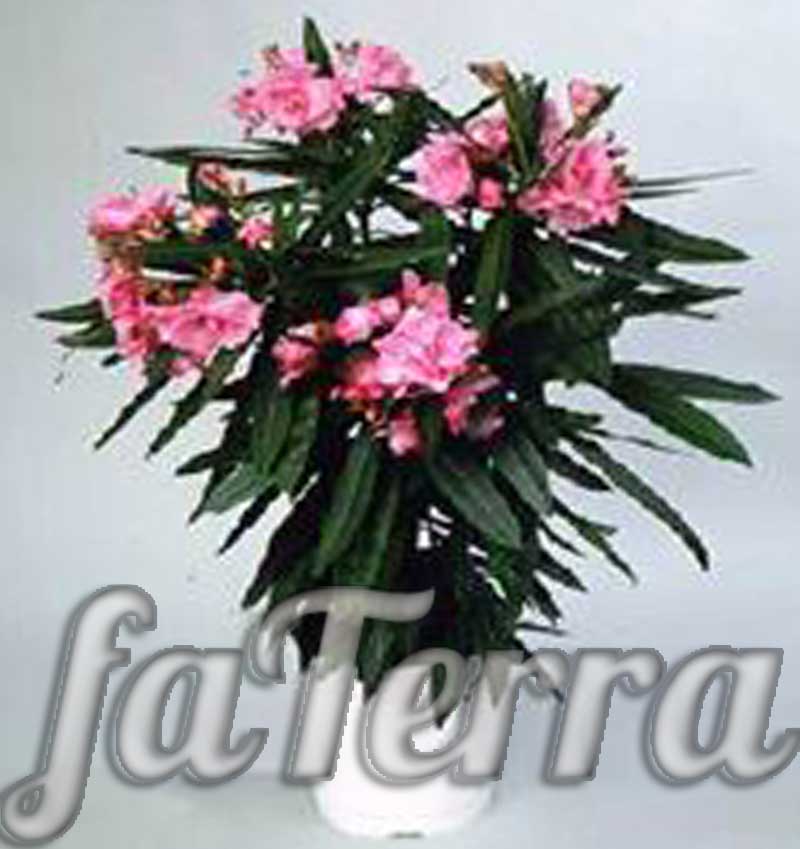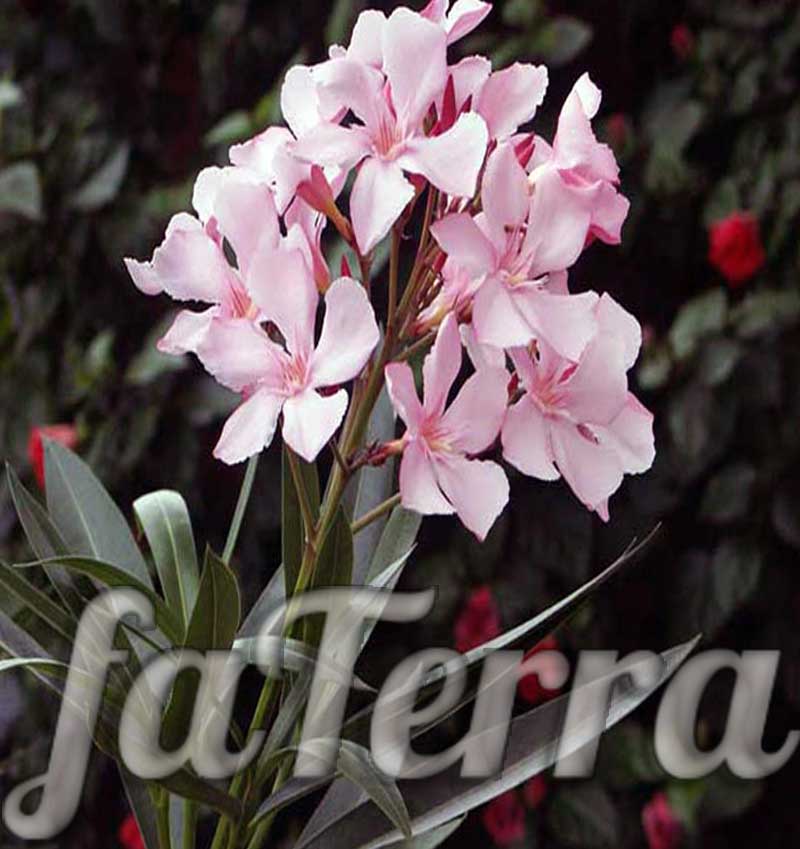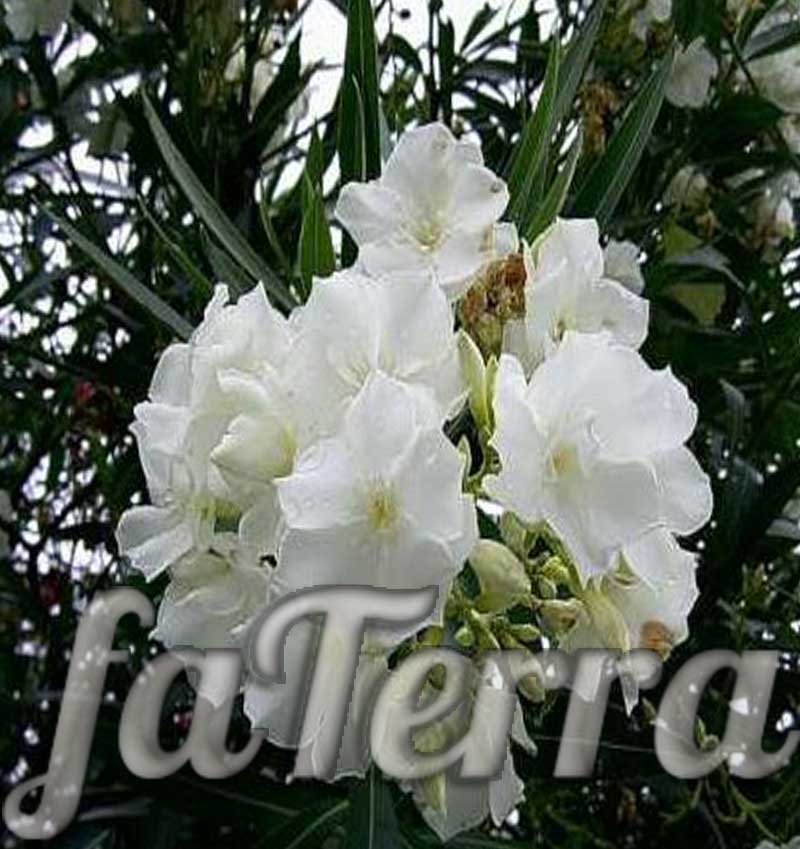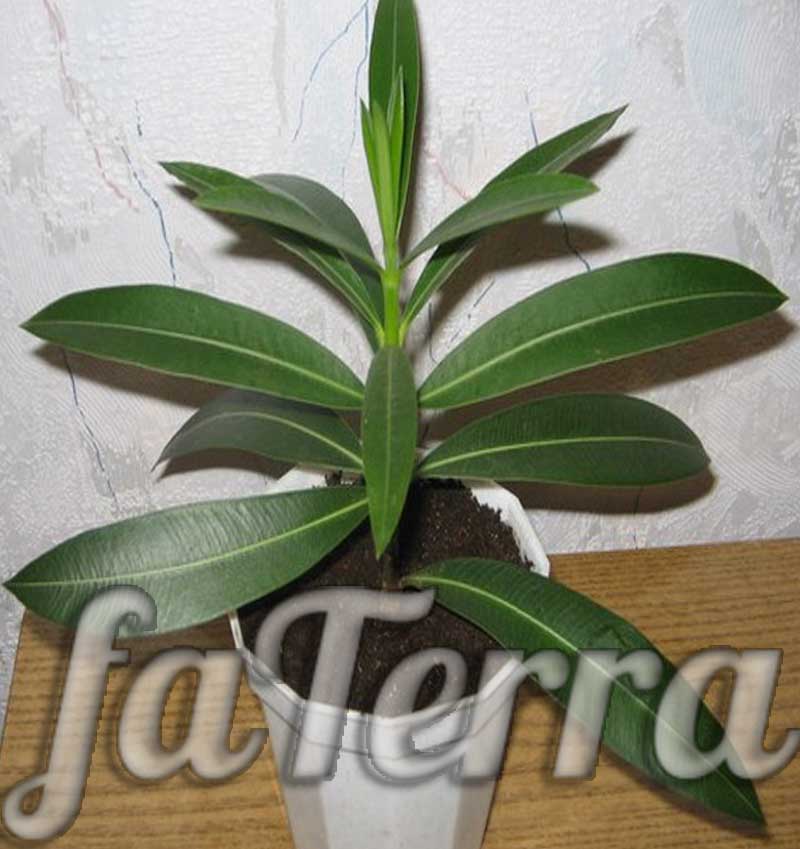Latin name: Nerium oleander
Homeland: subtropics of the Mediterranean, South Asia, Japan
Indoor oleander
Oleander plants show flowering, thermophilic, evergreen large-sized bushes or trees growing up to 4 m high, belong to the Kutrovye family (Apocynaceae). The stems resemble twigs, which form a light gray smooth bark on top. Oleander leaves are evergreen, arranged oppositely on short petioles. They have developed median veins, their shape is pointed-lanceolate, elongated up to 15 cm, and up to 3 cm wide.
The white or pink flowers of the plant, not exceeding 5 cm in diameter, are wheel-shaped, of correct addition, bisexual, originally collected in apical panicles, the shape of which resembles an umbrella. Corollas of white, yellowish, reddish or pink color have a limb with five lobes.
The oleander flower has a high rating, so breeders are actively creating and growing new original cultivars with flowers of various shapes. Especially beautiful is the oleander with terry petals. Flowering period from June to August. Multi-seeded fruit leaflets ripen in November, crack on the sides, scattering numerous hairy seeds with a tuft at the tip.
The natural habitat of the oleander is the subtropical regions of our planet. Homeland - the Mediterranean. The wild, heat-loving shrub oleander prefers wet shores of water bodies, drying up riverbeds. This beautiful plant lives in Southern Europe, North Africa, Japan, China. Toward the north, the oleander grows as a houseplant.
Oleander species
Common oleander (Nerium oleander)
Common oleander photo - liana This is the main common name that the oleander flower has and it is in its only form distributed as a houseplant. But you can hear other names - fragrant oleander, indoor oleander.
Common oleander is an upright branched shrub up to 4 m tall with evergreen leaves and chic fragrant flowers collected in lush racemose inflorescences. But ordinary oleander is known not only for its beauty and attractiveness. Its leaves and flowers are used for various diseases to restore the body's strength.
The oleander is also known for its many garden forms. Among themselves, they differ in the size of the bush, different colors of flowers, as well as their different aromas. And these varietal varieties sufficiently satisfy any tastes and wishes of flower growers.
White oleander
White oleander photo This is a common interesting ornamental shrub up to 5 meters high. Delightful unusual flower oleander, its leaves are leathery, attractive flowers with a wonderful aroma.
White oleander is a poisonous plant, but despite this it is used in pharmacology. From the leaves of the plant, a liquid extract, tinctures and some other preparations for the treatment of heart ailments are prepared.
Oleander room
Oleander indoor photoHe loves bright lighting very much, and 20 degrees is suitable for an acceptable temperature during the growth period. He loves fresh air very much, the room should be well ventilated. Winters at a temperature of 8-12 degrees and preferably in the light, so that the plant does not shed its leaves.
Oleander terry
Terry oleander photo It looks compact in size and has charmingly magnificent flowers collected in large inflorescences at the ends of the branches. An incomparable aroma comes from a beautiful and graceful terry oleander, which captivates with its splendor and elegance.
Oleander home care
Oleander is easy to care for and easy to grow. You can buy oleander in the store. When purchasing a small bush, you need to know that the oleander at home, with good care, grows to a height of more than two meters. In order to constantly adjust the size of the plant and form a beautiful crown, the correct pruning of the oleander must be carried out.
Oleander at home requires a lot of sunlight and prefers the area near the south window. The room should be well ventilated, and the optimum temperature during the growth period is 20-27 degrees. Winter temperature limits are 18-15 degrees. If there is little light for the plant in winter, the leaves will fall off, and in summer it will not bloom.
Water the oleander in spring and autumn with a little warm softened water after the top layer of well-drained soil has dried. In winter, watering the plant should be reduced to once every two weeks.
Oleander transplant
It is better to transplant a plant in the spring as a large number of roots grow, which need to be shortened more and reduce the amount of land in order to improve conditions for the growth and flowering of the oleander.
Oleander breeding
Oleanders can be propagated by seeds or cuttings. Cuttings should be rooted in soil or water. And in early spring, it is advisable to sow seeds in sand or peat soil. A young plant can already bloom in a year.
Pests and diseases of oleander
Oleander cultivation is not particularly difficult, but it is necessary to protect the plant from pests. There are cases of damage to the oleander by a scale insect, a red spider mite, a mealybug. Soot fungus appears from diseases, which is washed off with soapy water. The spread of diseases occurs at lightning speed, which means that pest control measures must be taken immediately. Treat the plants with a soapy solution, and if there is a lack of effect, repeat the treatment with chemicals.
Oleander use
- The oleander flower is beautiful at different times of the year, it looks original when planting, both one bush and plantings in groups. Often used in landscape design in subtropical areas. It looks great in the windows of huge shops, decorates working premises, offices, gazebos, benches.
- Oleander is widely used in medicine. The leaves of the plant are used, as well as dried flowers for topical treatment. Unique and effective extracts of the plant to improve immunity, widely used for headaches, exhaustion of the nervous system, insomnia, eczema.
You should always remember that oleander is a poisonous plant and take precautions when coming into contact with it with great care. The most poisonous is the milky juice of the plant and seeds. Oleander is poisonous, but smelling the flowers of the plant is not harmful to health, but chewing the leaves is absolutely contraindicated.
Love your unique plant, your scarlet flower and it will help you overcome life's difficulties.



















Write comments
Comments